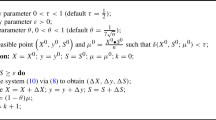Abstract
This paper considers the primal quadratic simplex method for linearly constrained convex quadratic programming problems. Finiteness of the algorithm is proven when \({\mathbf {s}}\)-monotone index selection rules are applied. The proof is rather general: it shows that any index selection rule that only relies on the sign structure of the reduced costs/transformed right hand side vector and for which the traditional primal simplex method is finite, is necessarily finite as well for the primal quadratic simplex method for linearly constrained convex quadratic programming problems.

Similar content being viewed by others
Notes
Of course there can be a case that the primal variable in our analysis is \(v_{j^*}\) and it’s complementary pair dual variable is \(u_{j^*}\). However, this situation does not effect the analysis, since it is not important whether the (primal) variable originally was a slack variable or not.
References
Akkeles AA, Balogh L, Illés T (2004) New variants of the criss-cross method for linearly constrained, convex quadratic programming. Eur J Oper Res 157(1):74–86
Anstreicher KM, Terlaky T (1994) A monotonic build-up simplex algorithm for linear programming. Oper Res 42(3):556–561
Bazaraa MS, Sherali HD, Shetty CM (2006) Nonlinear programming: theory and algorithms. 3rd ed, Wiley-Interscience, Hoboken, NJ
Bilen F, Csizmadia Z, Illés T (2007) Anstreicher–Terlaky type monotonic simplex algorithms for linear feasibility problems. Optim Methods Softw 22(4):679–695
Bland RG (1977) New finite pivoting rules for the simplex method. Math Oper Res 2:103–107
Chvátal V (1983) Linear programming. A series of books in the mathematical sciences. W. H. Freeman and Company, New York
Csizmadia, ZS (2007) New pivot based methods in linear optimization, and an application in petroleum industry. PhD Thesis, Eötvös Loránd University of Sciences, Budapest. http://www.cs.elte.hu/csisza
Csizmadia Z, Illés T (2006) New criss-cross type algorithms for linear complementarity problems with sufficient matrices. Optim Methods Softw 21(2):247–266
Csizmadia Z, Illés T, Nagy A (2012) The s-monotone index selection rules for pivot algorithms of linear programming. Eur J Oper Res 221(3):491–500
Csizmadia Z, Illés T, Nagy A (2013) The s-monotone index selection rule for criss-cross algorithms of linear complementarity problems. Acta Univ Sapientiae Inform 5(1):103–139
Dantzig GB (1963) Linear programming and extensions. Princeton University Press, Princeton
de Klerk E, Roos C, Terlaky T (2004) Nemlineáris Optimalizálás. Operációkutatás No. 5., Budapesti Közgazdaságtudományi és Államigazgatási Egyetem, Operációkutatás Tanszék, Budapest
den Hertog D, Roos C, Terlaky T (1993) The linear complementarity problem, sufficient matrices and the criss-cross method. Linear Algebra Appl 187:1–14
Illés T, Mészáros K (2001) A new and constructive proof of two basic results of linear programming. Yugoslav J Oper Res 11(1):15–30
Illés T, Nagy A (2014) Computational aspects of simplex and MBU-simplex algorithms using different anti-cycling pivot rules. Optimization 63(1):49–66
Illés T, Terlaky T (2002) Pivot versus interior point methods: pros and cons. Eur J Oper Res 140(2):170–190
Klafszky E, Terlaky T (1991) The role of pivoting in proving some fundamental theorems of linear algebra. Linear Algebra Appl 151:97–118
Klafszky E, Terlaky T (1992) Some generalizations of the criss-cross method for quadratic programming. Optimization 24(1–2):127–139
Lemke CE, Howson JT Jr (1968) On complementary pivot theory. Mathematics of decision sciences. volume Part 1. AMS, Providence, Rhode Island, pp 95–114
Murty KG (1976) Linear and combinatorial programming. Wiley, New York
Nagy A (2014) On the theory and applications of flexible anti-cycling index selection rules for linear optimization problems. PhD Thesis, Eötvös Loránd University of Sciences, Budapest
Terlaky T (1983) Egy új, véges criss-cross módszer lineáris programozási feladatok megoldására. Alkalmazott Matematikai Lapok 10(3–4):289–296
Terlaky T (1985) A convergent criss-cross method. Optimization 16(5):683–690
Terlaky T, Zhang S (1993) Pivot rules for linear programming: a survey on recent theoretical developments. Ann Oper Res 46/47(1–4):203–233
Tucker AW (1963) Principal pivotal transformations of square matrices. SIAM Rev 5:305
van de Panne C, Whinston A (1964a) Simplicial methods for quadratic programming. Naval Res Logist 11:273–302
van de Panne C, Whinston A (1964b) The simplex and the dual method for quadratic programming. Oper Res Q 15:355–388
van de Panne C, Whinston A (1966) A parametric simplicial formulation of Houthakker’s capacity method. Econometrica 34(2):354–380
van de Panne C, Whinston A (1969) The symmetric formulation of the simplex method for quadratic programming. Econometrica 37(3):507–527
Wolfe P (1959) The simplex method for quadratic programming. Econometrica 27(3):382–398
Zhang S (1997) A new variant of criss-cross pivot algorithm for linear programming. Eur J Oper Res 116(3):607–614
Zionts S (1969) The criss-cross method for solving linear programming problems. Manage Sci 15(7):426–445
Acknowledgements
Tibor Illés acknowledges the research support obtained as a part time John Anderson Research Lecturer from the Management Science Department, Strathclyde University, Glasgow, UK. This research has been partially supported by the UK Engineering and Physical Sciences Research Council (Grant No. EP/P005268/1).
Author information
Authors and Affiliations
Corresponding author
Additional information
Dedicated to Goran Lešaja in honor of his 60th birthday.
Rights and permissions
About this article
Cite this article
Csizmadia, A., Csizmadia, Z. & Illés, T. Finiteness of the quadratic primal simplex method when s-monotone index selection rules are applied. Cent Eur J Oper Res 26, 535–550 (2018). https://doi.org/10.1007/s10100-018-0523-1
Published:
Issue Date:
DOI: https://doi.org/10.1007/s10100-018-0523-1




